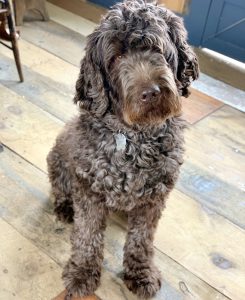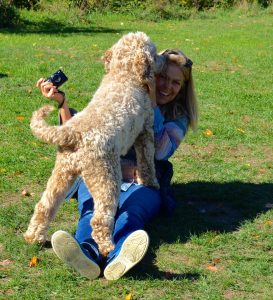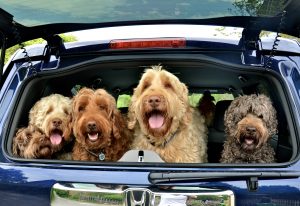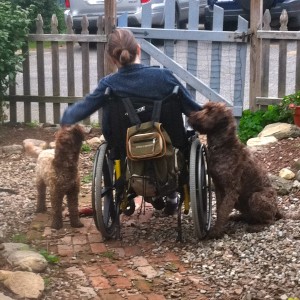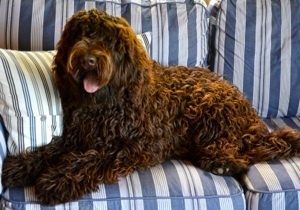Is the American Cobberdog right for you?
The breed purpose of the American Cobberdog is to have the qualities that make a great therapy dog. Those qualities include a dog that is friendly, patient, and enjoys engaging with people. Our dogs here at Berkshire Hills have also been selectively bred to be soft and sensitive to people’s emotions. But those qualities need to be carefully shaped. Wrong understanding or a heavy hand can create a dog with behavior issues.
They are an excellent breed, but they are still dogs. They can be goofy. They can make messes, and they need to learn how to live in our world, but do you have the patience to learn what they need and what they are trying to communicate with you?
Do you understand that it takes time and effort for a puppy to become a calm and connected therapy and companion dog?
Are you prepared for:
1. Training your puppy with positive methods only? That means no choke, prong, or shock collars? You can train your dog to have good manners by building a respectful relationship. Often, people resort to punishment methods because they don’t know what else to do or are not willing to take the time to learn. Find a good trainer who uses positive and relationship-based training.
2. Do you have realistic expectations for your puppy’s first two years? People often meet an adult Berkshire Hills dog and expect the same calm and connected temperament in their puppy. I have had several people call me worried that their puppy doesn’t have a therapy dog temperament. They say the pup has too much energy, they pull on the leash, they are chewing things, etc. Those calls usually come when the dog hits adolescence!
It’s important to know that a puppy goes through many stages in the first year or two. They nip, jump, poop in the house, have endless energy, go through fear stages, act like clowns, and get into stuff and chew things, to name a few typical puppy behaviors. How you respond and work with those behaviors determines how your dog matures into an adult.
American Cobberdogs are no different. The difference is that a Cobberdog has a soft nature. Punishment, misunderstanding or lack of patience can create anxiety in our dogs. The few dogs that have been returned to us usually have been the ones that were trained on a shock collar. They lost trust in their environment and their people, which caused fear and anxiety.
Building a respectful relationship is the key to creating an adult dog that connects with you and makes a good therapy dog.
- American Cobberdogs need to be groomed every 8-10 weeks, depending on the style you like. Between grooming appointments, you will need to keep their hair around their eyes trimmed, nails clipped, and ears cleaned.
4. Cobberdogs are alert barkers and will let you know if anyone is at the door or an animal is in the yard, and sometimes they alert you to things you just don’t see or hear (but they do!) At Berkshire Hills, I appreciate the alert. The dogs stop once I go check it out. Do you have the patience to understand your dog’s nature and work with it?
Breed Information
What is an American Cobberdog?
It is a newer breed bred for therapy and service work.
Cobber in Australia is slang for “my best mate or best friend.” Our foundation dogs came from Australia. We are not affiliated with the MDBA nor the Australian Cobberdog. The American Cobberdog has a different breed vision, standard, and DNA than the Australian Cobberdog, though both breeds were developed from the Australian Labradoodle. The American Cobberdog stopped infusing new breeds, whereas the Australians continue doing so.
How is it different from a Labradoodle?
For one, it’s a breed and not a cross. Its genetic makeup is completely different and has been selectively and purposefully developed as all other dog breeds have been. The American Cobberdog has far exceeded the requirements to be a pure breed, though the AKC will not recognize it nor do we want to be recognized by them.
American Cobberdogs are consistent in gentle temperaments, allergy/asthma friendly, nonshedding coats, and wonderful intelligence. These are the qualities we want in our dogs.
We continue to better the breed and have produced soulful, intelligent dogs that predominantly have beautiful wavy fleece coats.
For more information please visit the AMERICAN COBBERDOG CLUB!
 Is the American Cobberdog the right breed for you?
Is the American Cobberdog the right breed for you?
The American Cobberdog has a unique personality, all of it’s own. I would describe them as people lovers, human-like in their ability to comfort and communicate, very intelligent (always the star pupil in obedience class!), goofy and happy, strong athletes, calm companions (after the puppy stage!), and truly your best friend.
(photo courtesy of Rob and Kris Libon)
We breed proper “FLEECE” coats
The fleece coat is like human hair. It is a single coat with loose, loopy spirals. or soft waves. It feels soft to the touch.
The fleece coat is a lower maintenance coat needing a brushing once every week or so and rarely needs a bath.
It is non shedding and allergy/asthma friendly.
It resists dirt! A dog with a fleece coat can be covered in mud, but once dry, their coat becomes clean and sweet-smelling!
Colors and sizes
Measurement is taken at the shoulder. Standard (21″-24″) Medium (17″-20″) Mini (under 17″)
Colors
- Chocolate Rich chocolate brown color. All chocolates lighten up to a variety of chocolate shades. Most turn into cafe over time. True chocolate is a rare color. Pigment is a rose or chocolate color and eyes can be honey, amber or brown. Kiefer has remained chocolate.
- Cafe The color of a Latte. Some cafes have a silvery tone to it like espresso with milk. Cafes are be born chocolate but develop into a cafe in 1-3 years. Pigment is rose or chocolate with hazel, honey, or brown eyes. Mabel, Pip and Tasha are cafe.
- Parchment Puppies are born milk chocolate and turn a smoky cream resembling milk with a touch of coffee. Hazel is a parchment.
- Caramel The color of a caramel candy. Some caramel colored pups fade to a lighter caramel with time. Pigment is rose with honey, hazel or amber eyes. Carson is a caramel.
- Apricot The color of the inside of an apricot. This color is even all over the body. The pigment on apricot is black. This is how you can tell a caramel from an apricot.
- Apricot cream The ears are apricot , but the body is lighter, usually a warm cream.
- Red The color is similar to caramel but the pigment is black. Paloma is red, though we call her caramel because it is a better description of her color.
- Cream A warm creamy color. Pigment can be black or rose. Kipling and Alice are creams.
- Raven Black Black puppies will have black pigment. Some black puppies will turn silver.


